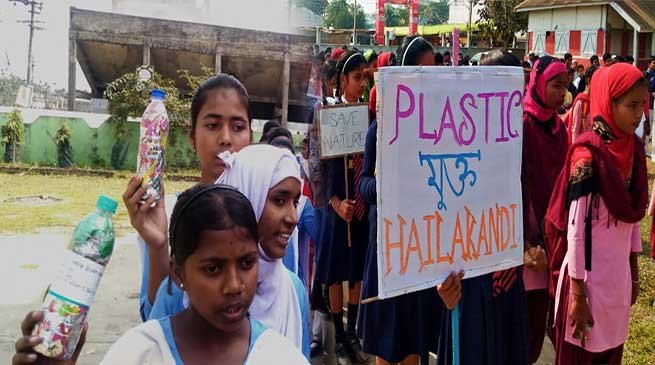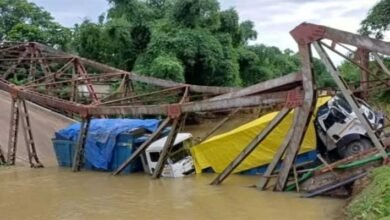Assam: Hailakandi adopts ecobricks to get rid of plastic waste

Hailakandi
After banning single use plastic, Hailakandi district is adopting ecobricks to get rid of plastic waste.
A programme was organised by the Hailakandi district of Assam administration here on Friday to generate awareness on plastic waste and how to convert plastic bottles and waste into ecobricks.
As part of the ‘Plastic Borjon Campaign’ to make Hailakandi a plastic free district, a foot march was also organised by the district administration in collaboration with the Hailakandi Municipal Board. The foot march was flagged off by Additional Deputy Commissioner, RK Dam.
The march that began from Government VMHS School traversed through the main thoroughfares of the town before culminating at Nazrul Sadan premises. Scores of school children who took part in the march carried plastic bottles filled with plastic waste.
Thanking the CRCC students and teachers for making ecobricks with plastic waste, Dam urged everyone to contribute towards making the environment free from plastic pollution.
The ecobricks made up of waste materials consisting of heap of plastic bags, mud and other non-biodegradable waste packed tightly inside plastic bottles, using a stick, will be used for building an Anganwadi centre at Singhalla under Lala development block.
12,000 plastic bottles stuffed with 4.5 lakh plastic waste and mud will be used for construction of the Anganwadi centre within 45 days at an estimated cost of Rs.3.46 lakh. The district administration, UNDP, Education department, Social Welfare department and PWD are the project partners.
“The cost effective earthquake resilient structure will not only help improve mother and child health status but also protect the environment through reuse and reduction of plastic waste,” said Dam. “Next time you hold a plastic bottle in your hand, try thinking of it not as rubbish to be disposed of, but as the building block for something extraordinary,” added Dam.
To mitigate the potential risks such as cracks appearing after drying due to shrinkage, liquid cement will be used. To prevent rooms from getting hotter during summer days, 140 holes will be made covered by aluminium net inside together with placing of 140 locally available grass plants in front of the holes to ensure adequate ventilation.
The story of ecobricks began in Guatemala, and from there via the Philippines, to South Africa. Susanna Heisse, horrified at the level of plastic waste around Lake Atitlán in Guatemala, first came up with the ecobrick idea. She built a wall out of them, which became an inspiration to others around the world.
Ecobricks represent a different approach to waste management. Plastics recycling is an energy intensive, polluting business, often involving long transportation distances. How might it be to find alternative uses for them at the local scale? Construction is one obvious approach. Ecobricks turn waste into a highly insulating, robust, affordable, building material, which simultaneously tackles problems of unemployment, waste and lack of housing. They can be used vertically as infill in timber-frame building systems, or horizontally, where they are mortared together with clay or cement.
“Switching over to ecobricks will help to uplift the local community and in bringing great attention to wastefulness. CRCC students and teachers have been a truly positive force in a number of ways and they can goad many people across the community into the journey to zero waste. It has been a hugely positive force,” District Social Welfare Officer, J. Daimary said, adding that the potential and possibilities ecobricks offer is immense.
As the world groans beneath the growing mountains of plastic waste and its toxic legacy, perhaps the solutions lie closer to home than the recycling plant. Perhaps the seeds being planted in Hailakandi, and the potential, as spotted by the district administration and other agencies, of ecobricks to catalyse a local economic renaissance, is an idea that could go to scale quickly. “By keeping waste local, it is perhaps the creativity and imagination that it stimulates that could turn out to be its longest lasting and durable legacy,” quipped Daimary.
The district administration with support from the Hailakandi Municipal Board has already set up plastic banks where citizens can go and deposit single-use plastic items, including bottles. And the collected plastic waste items can be turned into ecobricks in a big way, thus paving the way for zero waste district.










